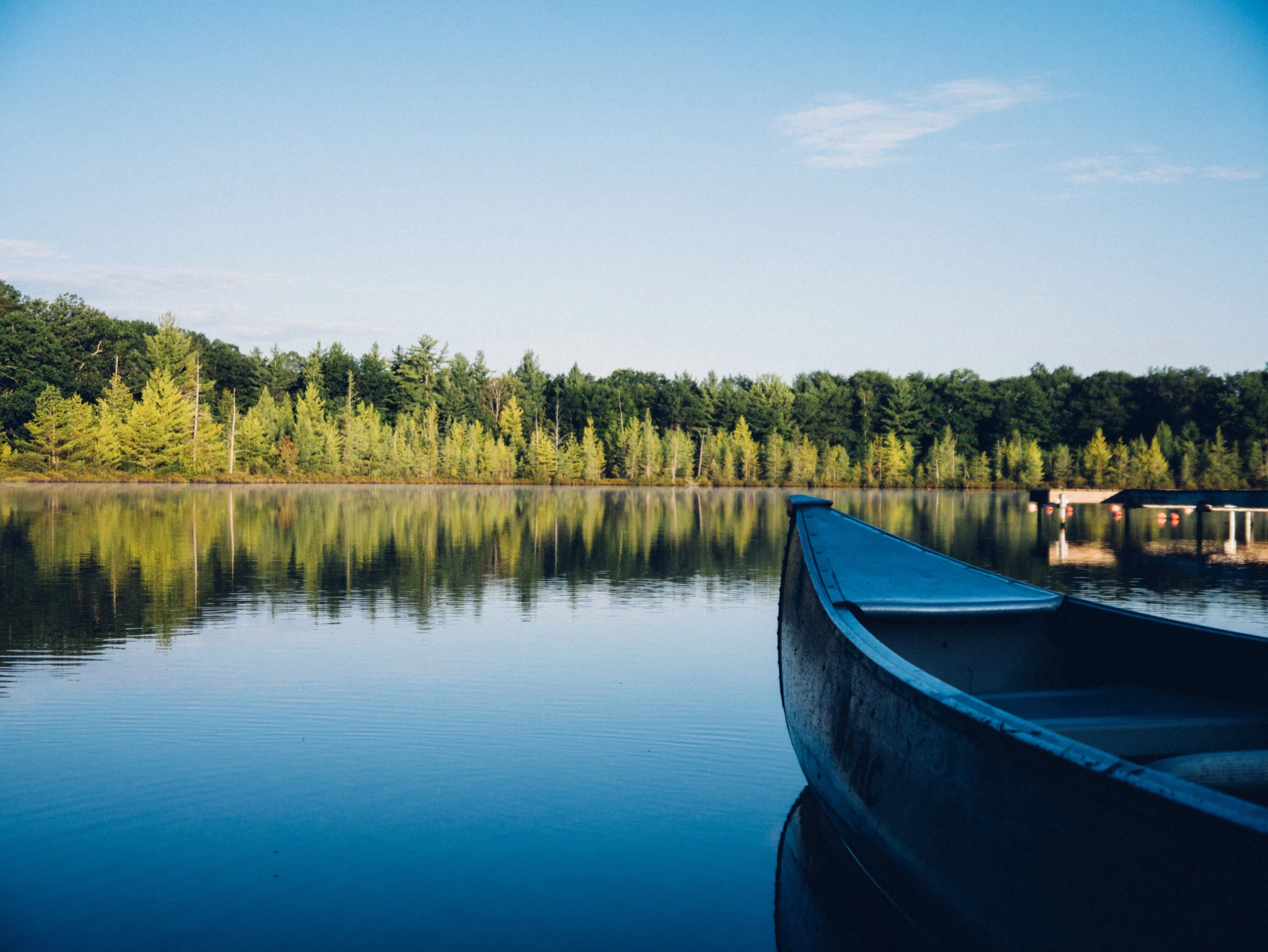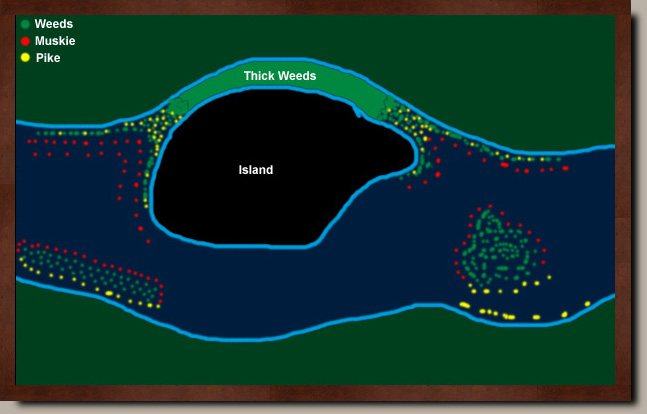
Professional Muskie Fishing Tactics
Muskie have a ferocious appetite and a competitive attitude, which makes them a fun fish to catch. Having the reputation of being a big tough fish means there is also a lot of folklore surrounding them. You may have heard that you have to troll really fast and use really big lures to catch them. This is not always true.
Where are the Muskie?
Muskie like weeds and will go deep into the weeds but generally they patrol the outside of weed-beds or at least close enough to the edge that they can ambush Walleyes and other fish. You will also find them around structure like deep humps, rocky points, off wild rice beds, shoals and around small islands. You will also find them around points leading into shallow weedy bays but not way back into the weeds. Muskie like structure that Pike and Walleyes like but they like structure that faces the open lake and in places where they have quick access to the large open parts of the lake. You can almost say Muskie are claustrophobic. As a result, most Muskie hunters troll along the shore and stay between structure and the open lake or on the outside of the weeds.
The diagram below shows the general behavior of Muskie. Muskie will still going into the thick weeds like Pike but generally they like to face the open water and have their prey trapped between them and the shore.

Trolling Speed
Muskie hunters find success trolling faster than they would for Walleye but there is a limit. A good Walleye speed is around 1.5 miles per hour. Many people fishing for Muskie will troll as fast as 10 miles per hour but the prime speed is between 4 and 6 miles per hour. You will catch Muskie trolling really fast and sometimes the really big Muskie hit the faster baits but trolling at a slower speed enables you to catch Muskie of all sizes.
Size of Lures
Traditional folklore also tells people new to Muskie fishing that you have to use really big lures. The truth is Muskie will hit any size lure. Tons of big Muskie get caught on little jigs used by people who are Walleye fishing. People trolling with both small, medium, and big lures catch Muskie. The size of the lure should be based on the amount of weeds in the area or the depth you want to fish at. Our Muskie lake is mainly clear water and not choked with weeds unless you go into the backs of bays so you can use bigger lures if you want. At the same time, being a clear lake, smaller lures have higher visibility thus you do not have to use big lures. The choice is up to you as it really does not matter. Muskie on our lake are hungry and hit everything.
The most important aspect of deep water Muskie fishing is letting out line to get to the bottom.
With open water, try trolling with bigger lures. The most popular big trolling lures for Muskie are J-ll Jointed Rapalas, J-13 Deeper Jointed Rapalas, Ziggy Lures, Willy Lures, Wiley Lures, Swimwizz, Believers, Large Mepps Bucktails, Lucky Strike Wooden Muskie Plugs, Hedon Muskie Plugs, large spinner baits, or long shallow-running Rapalas. Perch-color and Fire-Tiger are good during the day and red seems to be good in the evening. There are many different colors and some fishermen find unique color combinations that work well. In a lake with a high Smallmouth Bass population, try using brown or green colored lures.
When in weeds it’s better to use smaller lures. 4 or 5 inch Original Floating Rapalas (the skinny ones) or Thundersticks work well. The jointed J-11 Rapalas are also an excellent lure and seem to catch Muskie of any size. Spinner baits can be very affective as well.
Trick
If you have two or three people trolling in the boat, try having everyone troll with the same lure and at the same distance from the boat. This creates the look of a school of fish, which is very attractive to a Muskie.
Casting
If you want to cast into patches of Water Cabbage or between lines of thick weeds, various kinds of crank-baits work well. Crank Baits, Jerk Baits, Spinner Baits, Dardevle Spoons, Suick, Large Mepps Bucktails, Rattle Baits, Spooks, and Jitter Bugs are very popular. Large spinner-baits are also very effective where there are lots of logs in the water.
Weather
Sunny hot days or windy cold days with rain; it does not seem to matter. Many fish start their feeding cycles when atmospheric pressure changes. The Muskie seem to like it when the pressure and weather stay consistent, no matter how nice or miserable it is on the lake.
Steel Leaders & Line
You must use steel leaders at all times. It’s best to use black leaders as sometimes a Muskie will see a silver shine ahead of the lure and hit the top of the leader and bite through the line. It does happen. The line you use should be based on the size of the fishing rod you use. In open water with a light-to-medium action rod, many people use 10 to 12 lb test line. In areas where there are thicker weeds, 12 to 15 lb test line can be used. What is really getting popular is the braided line. You can get 15 lb test line, which is as thin as 6 lb. If you plan on doing a lot of Muskie fishing and you think your fishing line is going to see a lot of abuse, then try going to the 20 lb braided. It will last longer and stay strong.
The secret to Muskie fishing is to have patience and try everything. You can fish for hours and hours and not catch anything and then start hitting them like crazy for an hour or two and then it stops dead again.
Best Muskie Lures
Muskie and Pike Casting Lures
- Crank Baits
- Jerk Baits
- Spinner Baits
- Dardevle Spoons
- Suick
- Large Mepps Bucktails
- Rattle Baits
- Spooks
- Jitter Bugs
Pike and Muskie Trolling Lures
- J-ll Jointed Rapalas
- J-13 Deeper Jointed
- Rapalas
- Ziggy Lures
- Willy Lures
- Wiley Lures
- Believers
- Swimwizz
- Large Mepps Bucktails
- Lucky Strike Wooden
- Muskie Plugs
- Hedon Muskie Plugs
Pike and Muskie Flies
- Rabbit Strip Pike Bunny
- Dahlberg Diver
- Red & White Pike Fly
Let us help plan your next fishing adventure!
We can accommodate singles, families, or groups with up to 10 people in one cabin.
